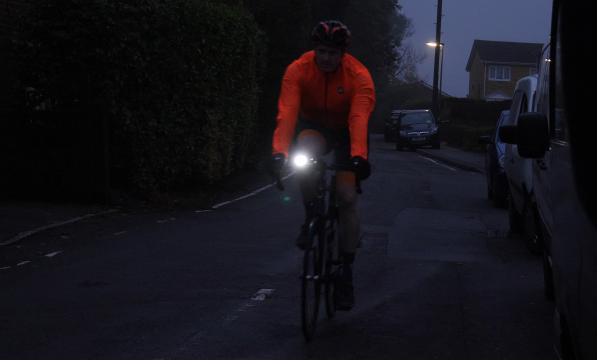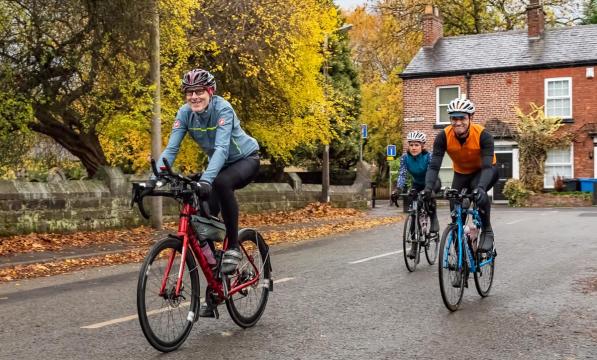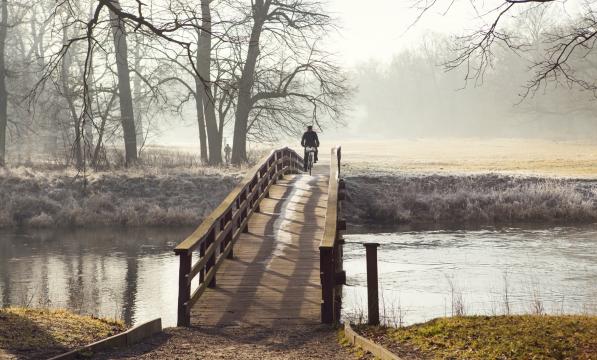How to stay safe cycling and driving on icy roads

Winter is definitely here and temperatures are dropping all over the country. As colder weather comes in, lying water will freeze on our roads, and all road users should be aware that the sun will be low in the sky.
Cycling UK and the AA, Britain’s largest motoring organisation, have joined forces to provide us all with the advice to stay safe.
Many cyclists will reach for the car keys in cold, icy weather and if you don’t feel comfortable cycling in such conditions, you should never feel like you have to.
Just as many hardy souls will continue riding, though, which is just as valid. This advice from Cycling UK and AA president Edmund King will help us all feel confident and remain safe while cycling or driving in the icy conditions.
Be prepared
First, look at your bike setup. When it comes to tyres, fatter and flatter is best. If you’re so inclined, and you’ve got the clearance, swapping your tyres for wider ones will improve grip. Otherwise just letting a bit of air out can make a real difference. The increased contact with the road will help improve grip.
You should also ensure your bike is fitted with the correct lights and reflectors, front and rear. It’s a legal requirement to use these between sunset and sunrise, but you might want to switch those lights on in all low light conditions.

Reflective elements on you and your bike are also good for increasing visibility, especially on moving parts like your hands and feet. Winter cycling kit often incorporates reflective materials for just this reason.
Low winter sun is a hazard for all road users, so take extra care and be observant.
Once your bike is kitted out, it’s time to consider your own kit. Dress appropriately for the weather. Layers work best for trapping warm air and regulating your temperature while you ride.
Pay particular attention to your extremities. Cold hands and feet can make any ride miserable. A thin woolly hat – worn under your helmet should you choose to use one – will keep your head toasty. A thermal jacket will come in handy if you need to stop for long periods.
Adapt to the conditions
You’ll also want to adjust your riding style. First, slow down. Now is not the time to be going for those Strava records. Take it easy and leave earlier than usual to give yourself more time.
Avoid sharp braking or sudden changes of direction as these are likely to make you lose control. Keep your braking smooth and controlled. Don’t pull hard on the levers and try using just the back brake as you don’t want to lose traction on your front wheel. Similarly, avoid sudden steering movements or you may well lose that front wheel.
Keep in mind that stopping distances will be longer and factor that into your braking.
Road positioning matters too. Stay out of the gutter. This advice stands no matter the conditions, but following a freeze the sides of roads can be treacherous. Take the primary position where you can. This also makes you more visible to other road users.
When puddles have frozen over cyclists face a minefield of icy patches, especially at the side of the road where so much water has accumulated because drains have been unable to cope. Drivers need to bear that in mind and give cyclists a wider berth when overtaking
Edmund King, AA president
Plan your route. You might normally stick to back roads, but these are less likely to be gritted. Main roads will be gritted, while the heavier traffic flow will help dry out the tarmac. This means you can choose your line accordingly. This simply means sticking to those drier areas where possible, usually following in the tyre tracks of drivers, and avoiding those icy patches.
That might not be possible all the time. In which case ride as carefully and smoothly as you can, applying our advice regarding braking and steering. If there’s an extended stretch of ice you could even get off and walk.
Expert advice
Edmund King, AA president, said: “All road users need to ensure they get into a winter mindset during that first hour of the day. People need to appreciate that potentially they will not stop in the same sort of distances they normally would.
“Cold snaps often come fast on the heels of heavy rain. When puddles have frozen over cyclists face a minefield of icy patches, especially at the side of the road where so much water has accumulated because drains have been unable to cope. Drivers need to bear that in mind and give cyclists a wider berth when overtaking.
“The low winter sun can also be a particular problem at this time of year, especially as it's at its most dazzling at the end of the morning commute and the beginning of the evening rush hour from 4-5pm, when the roads are at their busiest.

“We would advise drivers to get up at least 10 minutes early to give time to prepare the car. Don’t drive off like a tank commander, with a tiny hole cleared in the windscreen. Clear all windows using a scraper and de-icer to ensure good all-round vision. If you drive an electric vehicle (EV) utilise the pre-heating function if your car has it.”
The AA website provides detailed advice about winter driving and coping with snow, cold and ice, as well as a list of general tips for drivers regarding cyclists.
Edmund King added: “Cyclists are more vulnerable than car users. They have the same rights on the road and drivers should remember they are sharing the road with cyclists.
“Recent Highway Code changes are set out to offer more protection to cyclists and pedestrians, meaning drivers should give as much room as practically possible when overtaking a cycle and give priority to both when negotiating a turn – Highway Code Rule 163 illustrates one car’s width – they may have to move out to avoid hazards like drains, potholes, or other debris on the road that you may not be able to see. And now ice has added to the potential dangers.”




